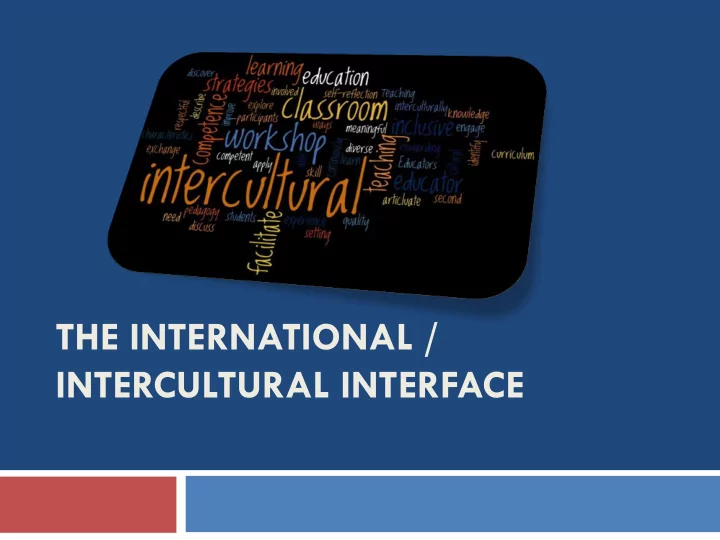

THE INTERNATIONAL / INTERCULTURAL INTERFACE
Has internationaliztion lost it’s way? Is internationaliztion a goal unto itself or a means to a goal? If so, what is the goal?
Questions – Knight (2004) What are the expected benefits or outcomes? What are the values that are underpinning it? Who are the main actors, stakeholders, and beneficiaries? What are the positive consequences, what are the unintended results, and what are the negative implications?
Traditional Rationales 4 Knight & de Witt (2002) Socio- Academic Cultural Political Economic
Approaches Activity (mobility) Knight & de Witt (1999) Internationalization Outcome Knight (2004) (competencies) Process Ethos (@Home) Cross-border Rationales
Intercultural Education Intercultural Education is more inclusive than International Education All students, regardless of their location, need to develop the capability to contribute in the intercultural construction, exchange and use of knowledge. (Crichton et al., 2004)
Static Majority 90% of domestic students are left out of the • internationalization process new ideas are needed on how best to expose these • students to international and cross-cultural perspectives "How can we have internationalization if we don't involve • the static majority?" • • Elsbeth Jones
Employer Perceptions 90% of employers valued intercultural skills (AACU, 2012) 93% valued critical thinking and communication over academic major or GPA (Hart Research Associates, 2013)
Interculturalizing the Players Students Educational Priorities Staff Teachers
Changing demographics # of international students in Canada has more than doubled since 1998 Provincial and National targets aim for substantial increases Immigration represents over 70% of Canadian population growth 1 in 5 Canadians allophone Aboriginal youth fastest growing population By 2031 almost half (46%) of Canadians over the age of 15 will have been born outside of Canada
What is Culture? “Culture hides much more than it reveals, and strangely enough what it hides, it hides most effectively from its own participants. Years of study have convinced me that the real job is not to understand foreign cultures but to understand our own.” E.T. Hall (1959)
Culture Influences: Communication Styles Approaches to Attitudes toward Knowledge Conflict Attitudes toward Approaches to Disclosure Tasks Decision Making Adapted from DuPraw and Axner, Toward a More Perfect Union in an Age of Diversity
Complementary Concepts Intercultural sensitivity The ability to discern and experience relevant cultural differences Intercultural competence The ability to think and act in appropriate ways that support the achievement of goals in culturally diverse contexts. (Deardorff,2013)
Building Competence - Howell’s Staircase Unconsciously Competent ‘Magic’ Consciously Competent ‘Target’ Consciously Incompetent ‘Transit’ Unconsciously Incompetent ‘Danger’
How to Develop IC? Cultivate Cultural Self-awareness Include Attitudes, Knowledge & Skills Use theory based frameworks (Deardorff, King & Baxter-Magolda, Bennett) Use Culture General Frameworks (Hofstede, Trompenaars, Minkov, Ting-Toomey) Revisit Curricula (Leask) – GCE (Shultz, Abdi) Experiential Learning & Applied Learning Encourage reflection
Deardorff’s Questions Do I measure student’s behaviour based on my own culturally conditioned expectations? What worldviews are demonstrated through the materials we currently use? Does my communication style alienate some learners? Can I demonstrate or mentor intercultural development? How can I help students develop an “intercultural lens”?
QUIC Intercultural Learning Cycle Generate “Something’s Up!” STARTING POINT Experience Outcomes Common group experience & potentially disorienting experience Taking Informed Personal Identity Action & Self-awareness Outcomes Work Attitude shift, Review Goals, new Outcomes practice Value personal culture & ability to suspend judgment Knowledge & Observation & Skills Reflection Outcomes Outcomes New reference Check assumptions points, approaches What do I need to Adapted from the work know? of D. Kolb and NorQuest College
Norquest’s Inclusion Fusion http://www.norquest.ca/NorquestCollege/media/pd f/centres/intercultural/ISE/Inclusion_Infusion.pdf
Interculturalizing @H - TRU https://www.youtube.com/watch?v=LSddFEdCY0c
Thank You Dr. Kyra Garson kgarson@tru.ca Centre for Student Engagement & Learning Innovation Thompson Rivers University
Recommend
More recommend